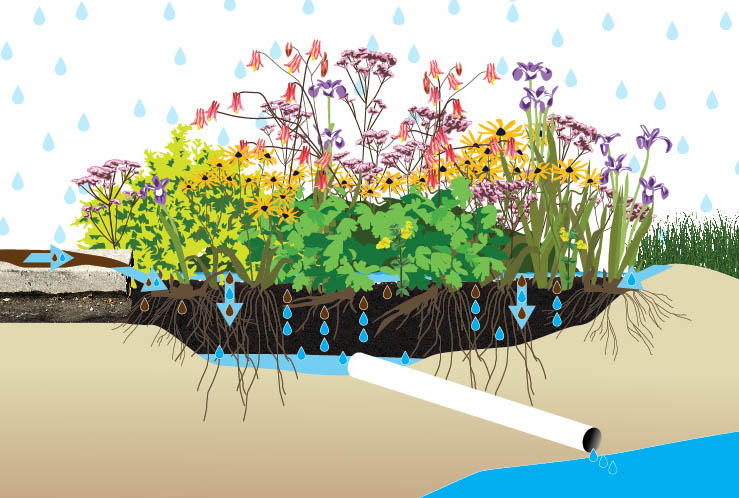Green Infrastructure 101
Green infrastructure practices are site-specific stormwater management techniques that mimic natural hydrologic processes to slow down, provide storage, infiltrate, and allow the evaporation of rain and snowmelt where it falls. Alternatively, grey infrastructure – gutters, storm drains, pipes – is only designed to move stormwater away from the property into a stormwater pond or directly into a waterbody via a stormwater outfall. Examples of green infrastructure include:
Rain Barrels and Cisterns

Barrels, tanks and cisterns that capture roof water and store for a later use such as landscape irrigation, boat washing, etc.
Rain Gardens

Depressed areas with engineered soils and native and/or long-rooted plants to collect stormwater that allow it to be stored, be taken up by plants, or infiltrate into the ground.
Green roof

Roofs designed with a waterproof membrane, drainage system, and a layer of plants to capture and absorb water.
Bioswales and Hybrid Ditches

Shallow channels designed with engineered soils, an underdrain, and planted with grass or native plants that help slow stormwater, filter out pollutants, and allow water to soak into the ground.
Permeable Pavement

Permeable pavement systems allow stormwater and snowmelt to soak through the surface through pores, joints, or gaps, and into the ground below.
Infiltration Practices

Infiltration practices capture and temporarily store stormwater, before allowing it to soak into the ground.
Tree and Planter Boxes
Compact stormwater collection systems that filter stormwater through layers of mulch, soil, and trees or plants.
Downspout Disconnection

Discharge of downspout reconnected into a rain garden, planter box, grassy area where it can soak into the ground, rain barrel, or cistern.
Buffers

Grassy, landscaped, or native planted strips that intercept stormwater and debris from paved areas to prevent pollutants from going directly into a waterbody.
Constructed/Engineered Wetlands
Designed wetland system that uses natural hydrologic processes and wetland vegetation to slow down stormwater and capture pollutants.
Native Landscaping

Landscaped areas planted or restored with native vegetation.
Preserving and Enhancing Wildlife Habitat

Maintaining and enhancing natural areas including trees, shorelines, and wetlands.
RESOURCES FOR HOMEOWNERS

Green infrastructure methods slow down, store, and filter rain water before it reaches the storm drain or other water source. This improves water quality and increases flood protection. Green infrastructure comes in many different shapes and sizes, from large networks of urban parks and wetlands to smaller projects like bioswales, rain gardens, green roofs, and rain barrels.

